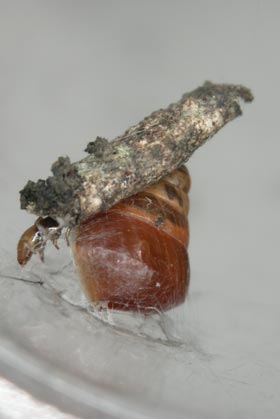Flesh-Eating Caterpillars Discovered in Hawaii
In Hawaiian rain forests, scientists have discovered caterpillars with a taste for escargot: They trap snails on leaves using silk webbing and then eat them alive.
These are the first caterpillars known to eat snails or mollusks of any kind, an evolutionary adaptation likely enabled by the island chain's isolation. The insects are also the first caterpillars known to use silk to ensnare prey in a spiderlike fashion.
"It's really remarkable—even within a diverse genus it's remarkable," said Daniel Rubinoff, an entomologist at the University of Hawaii at Manoa, who led the discovery team.
The caterpillars belong to the genus Hyposmocoma, a large and diverse group of moths and caterpillars that have adapted to nearly every ecological niche on the Hawaiian Islands, Rubinoff said.
Of the more than 350 known species that make up Hyposmocoma, most have plant-based diets. But researchers have discovered four species of caterpillars that eat snails to date.
To attack their shelled prey, the flesh-eating caterpillars wait for snails to come to rest. After poking them to make sure they're still alive, the caterpillars then use silk to bind the snails down.
Next, the caterpillars, which are covered in their own silk casings, emerge from their casings to reach into the snails' shells and begin eating the trapped snails alive.
Some satiated caterpillars then attach the empty snail shells onto their speckled casings. This likely serves as camouflage.
Rubinoff and graduate student William Haines describe the discovery of one of the four snail-eating caterpillar species in tomorrow's issue of the journal Science.
Why Hawaii?
Rosemary Gillespie, an insect biologist at the University of California at Berkeley, said the discovery fits the image of Hawaii as a place full of unusual evolutionary surprises.
"It's so isolated. Prior to human contact very few organisms got there, and the ones that did get there found an open palate upon which to diversify," she said.
MOST POPULAR STORIES
Photo in the News: Oldest Known Maya Mural Reveals Royal TaleArchaeologists have revealed the final wall of the earliest known Maya mural, sa... |
Oldest Known Maya Mural, Tomb Reveal Story of Ancient KingArchaeologists have revealed the final wall of the earliest known Maya mural, sa... |
King Kong Island Home Is Pure Fantasy, Ecology Experts SaySkull Island, the mythical home of the great ape King Kong, is supposed to lie i... |
|
||||||||||









